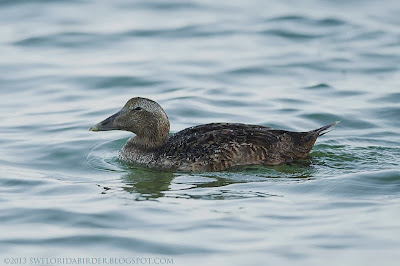Thursday September 19th
 |
| Eastern Kingbird photographed By Bob Pelkey at "the Annex" |
Today I joined with
Bob Pelkey - wildlife photographer and expedition leader - on a day trip across the state to visit birding hotspots in Miami-Dade County. It was a long, hot day starting for us about four-thirty in the morning. As we headed east, a goal of a one hundred count day was set and we soon had our first bird of the day with a
Limpkin calling in the pre-dawn darkness as we passed through Collier County.
 |
| Bob Pelkey in Action |
Just a few days ago our friends
Dr Padilla and Master Birder, Vince McGrath had made the same trip and had a very good experience at our first stop at "The Annex" on Aerojet Road within the Frog Pond WMA, which is just east of the entrance to Everglades National Park. Of special interest here besides migrating warblers were the reports of continuing alder flycatchers and a willow flycatcher.
Bob and I arrived about seven-thirty and encountered a large crew of workers armed with machetes assembling at Lucky Hammock. We learned that they were employed by the South Florida Water Management District to clear out exotic foliage, so moved on down the road toward The Annex for the flycatchers. But first we were stopped at the gate by an employee for SFWMD. We'd have to leave the car there and walk the site. The location was being closed off due to folks using the remoteness to conduct non-wildlife viewing activities.
We spent a couple of hours here and dipped on the flycatchers, In fact birding wasn't to exciting. Lots of Eastern Kingbirds were present, did get a female Black-throated Blue Warbler and a Northern Parula. A flock of migrating Bobolinks was observed passing overhead and White-eyed Vireos and Cardinals did call from the dense foliage. Only swallows recorded all day were seen here with seven Purple Martins perched on the wires and a lone Barn Swallow flying overhead. As we were leaving we added a Merlin, several Eastern Meadowlarks and Killdeer in the plowed fields. Added Common Myna in Florida City.
 |
| Common Myna in Florida City |
From here we moved onto Matheson Hammock County Park in Coral Gables. We found very little activity in the picnic area or along the service road area. We did manage a nice male Black-throated Blue Warbler, Red-eyed Vireo, a Peregrine Falcon and a Yellow-throated Vireo (265). A lady riding her bike told us of a large flock of birds near the swimming beach, which turned out to be a large number of Wilson's Plover and Ruddy Turnstones, plus a lone Least Sandpiper.
 |
| Graylag Geese in Kendall |
From here we checked out the nearby University of Miami Campus were we had good success with exotic birds last year, but with the campus busy with the purpose of education, we left for A.D. Barnes Park. Finally at
Barnes, near the pool, we found some birds. Over the coarse of several hours we encountered
American Redstarts, Tennessee Warblers, Ovenbirds, Northern Parula, Red-eyed Vireos, Acadian Flycatchers (266), Worm-eating Warbler, Black-and-White Warblers, a pair of White-crowned Pigeons, a Peregrine Falcon and a Common Hill Myna (267).
 |
| Egyptian Goose at Kendall |
At a stop at the Kendall Baptist Hospital campus Bob tried getting pics of the Mitred Parakeets in flight, but they were just too fast on the wing. Had to have been at least sixty parakeets on hand. At the pond we added a pair of Egyptian Geese, scores of feral Muscovy Ducks, Pekin Ducks and Graylag Geese. As we headed for home and enjoying urban traffic conditions we sighted several Monk Parakeets, a few White-winged Doves, Eurasian Collared Doves, Rock Pigeons and the usual city bird life. More Muscovy Ducks and another Egyptian goose.
It was a good trip, but we come up short on our hundred count goal. Looking forward to seeing Bob's pics.
Day Count (70) -
 |
| Feral Muscovy Ducks |
Egyptian Goose, Mottled Duck, Mallard (Domestic type), Muscovy Duck (Feral), Double-crested
Cormorant, Anhinga, Brown Pelican, Great Blue Heron, Great Egret, Snowy Egret, Little
Blue Heron, Tricolored Heron, Cattle Egret, Green Heron, White Ibis, Limpkin, Black
Vulture, Turkey Vulture, Osprey, Red-shouldered Hawk, Common Gallinule, Wilson's
Plover, Killdeer, Ruddy Turnstone, Least Sandpiper, Laughing Gull, Rock Pigeon,
White-crowned Pigeon, White-winged Dove, Eurasian Collared-Dove, Mourning Dove,
Common Ground-Dove, Belted Kingfisher, Red-bellied Woodpecker, Northern Flicker,
Pileated Woodpecker, Merlin, Peregrine Falcon, Monk Parakeets, Mitred Parakeet,
Acadian Flycatcher, Great Crested Flycatcher, Eastern Kingbird, Loggerhead
Shrike, White-eyed Vireo, Yellow-throated Vireo, Red-eyed Vireo, Blue Jay, American
Crow, Fish Crow, Purple Martin, Barn
Swallow, Carolina Wren, Blue-gray Gnatcatcher, Northern Mockingbird, Common
Hill Myna, Common Myna, European Starling, Ovenbird, Worm-eating Warbler, Black-and-white
Warbler, Tennessee Warbler, American Redstart, Northern Parula, Black-throated
Blue Warbler, Northern Cardinal, Bobolink, Red-winged Blackbird, Eastern
Meadowlark, Common Grackle and Boat-tailed Grackle
Animals - Red Fox and Raccoons (A D Barnes Park)







.jpg)



























